In the ever-evolving landscape of cyber threats, deceptive email tactics have become a prevalent danger, posing significant risks to businesses. This blog, unveils the covert world of email-based cyberattacks, emphasizing the critical need for businesses, especially those in the legal sector, to fortify their defences.
At IGTech 365, we are committed to providing managed and outsourced IT services that act as a formidable shield against these deceptive email tactics.
Understanding Deceptive Email Tactics
1) Phishing Emails: The Art of Deception
In the intricate realm of deceptive email tactics, phishing emerges as a formidable threat, with its covert methods often concealed within two insidious variants: clone phishing and spear phishing.
Clone phishing entails a meticulous replication of legitimate correspondence, where cybercriminals craft emails to mirror authentic messages. This deceptive technique seeks to exploit the trust established through familiar communication channels, tricking recipients into divulging sensitive information.
On the other hand, spear phishing represents a more targeted and personalized approach, where cyber adversaries tailor their messages to specific individuals. These malevolent actors employ sophisticated tactics, leveraging information about the target to create seemingly trustworthy emails that facilitate data theft or unauthorized access.
By understanding the nuances of clone phishing and spear phishing, individuals and businesses can fortify themselves against the ever-evolving landscape of cyber threats, creating a resilient barrier that safeguards sensitive information and preserves the integrity of digital communications.
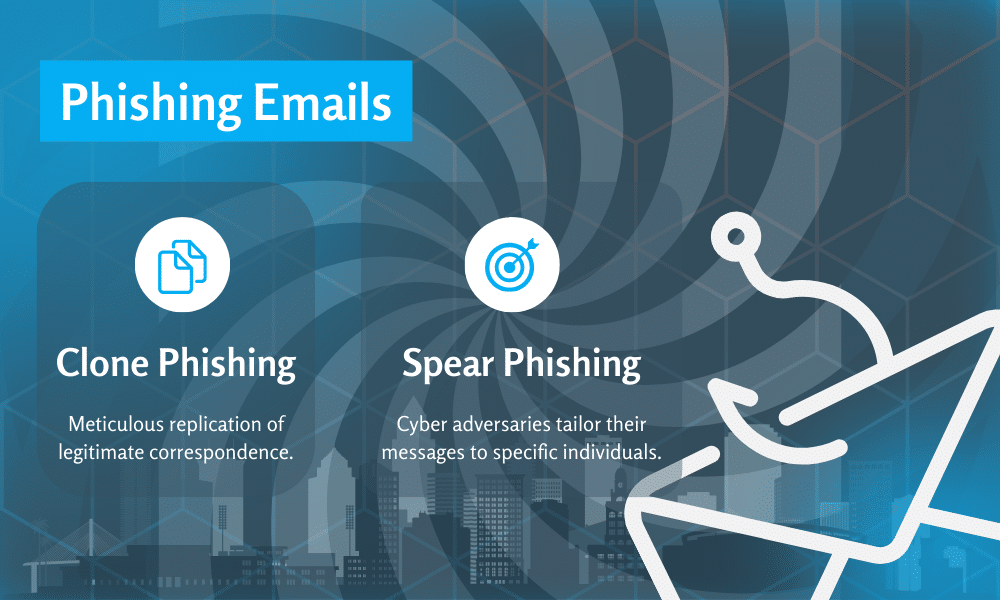
2) Spoofed Emails: Unmasking the Impersonators
Email Spoofing and Display Name Spoofing, two deceptive techniques within the arsenal of cyber adversaries, intricately manipulate the sender’s information, instilling a false sense of legitimacy in recipients.
Email Spoofing involves the forgery of email headers to falsely represent the sender’s identity, while Display Name Spoofing manipulates the display name to mimic a trusted source.
In dissecting these tactics, it becomes crucial for businesses to recognize the subtleties of these maneuvers.
The essence of protection lies in understanding that appearances can be deceiving.
By empowering businesses to discern the red flags associated with altered sender information, they can fortify their defenses against these deceptive techniques.
Heightened awareness and a keen eye for anomalies become invaluable tools in the fight against email-based cyber threats, ensuring that businesses can navigate the digital landscape with confidence and resilience.
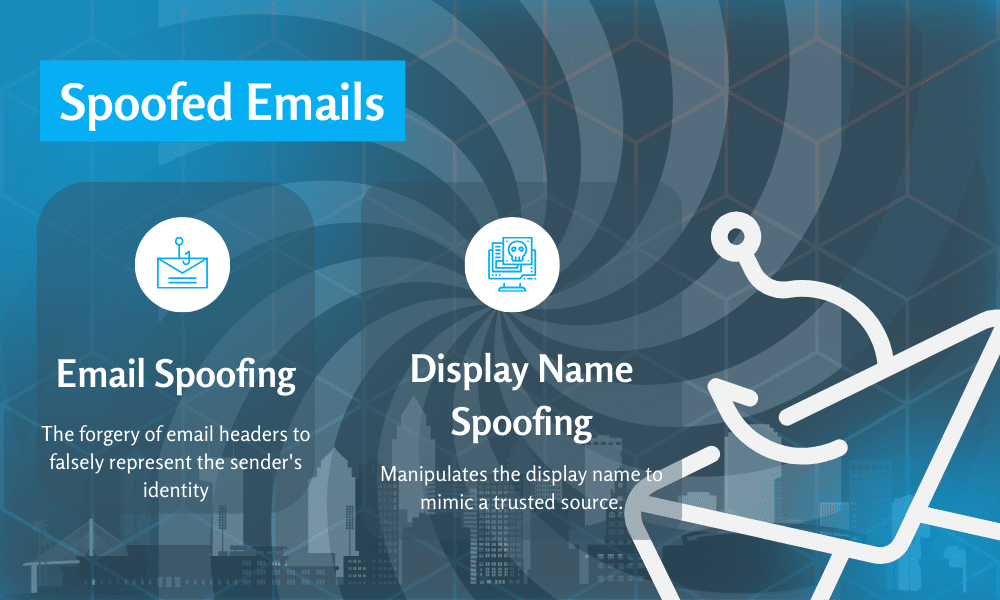
3) Malware-Laden Emails: The Silent Threat
The realm of cybersecurity is plagued by the subtle yet destructive nature of malware-laden emails, where cybercriminals employ insidious tactics to compromise systems and undermine data integrity.
In the intricate dance between attackers and defenders, attachment-based malware poses a potent threat by concealing malicious software within seemingly harmless files, deceiving users into unwittingly triggering harmful actions.
Simultaneously, the menace of link-based malware unfolds as cyber adversaries exploit hyperlinks embedded in emails to direct users to compromised websites, facilitating the surreptitious delivery of malicious content.
This dynamic duo of attack vectors operates stealthily through email channels, making detection challenging and rendering systems vulnerable to infiltration. As organizations strive to fortify their digital defences, a nuanced understanding of these tactics is paramount, enabling proactive measures to thwart these malicious payloads and fortify the integrity of critical data and systems.
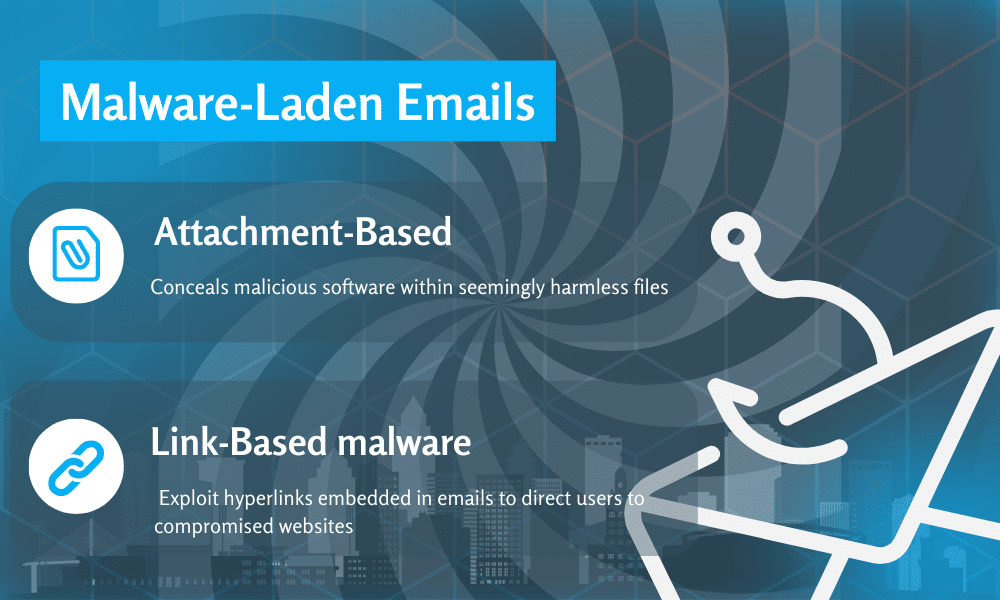
4) Business Email Compromise (BEC):
Unravelling the intricacies of CEO Fraud, a nefarious subset of Business Email Compromise (BEC), exposes a highly sophisticated tactic wherein cybercriminals strategically impersonate high-ranking executives. In this deceptive maneuver, malevolent actors exploit the inherent trust and authority associated with executive roles to trick unsuspecting employees into transferring funds. The potential financial ramifications for businesses are profound, as these fraudulent transactions often involve substantial amounts of money.
The intricacy of CEO Fraud lies in the meticulous crafting of emails that mirror the communication style of top-level executives, making it challenging for employees to discern the deceit.
As a result, businesses face not only direct financial losses but also reputational damage and operational disruptions. This tactic underscores the critical need for heightened cybersecurity awareness and stringent verification protocols to safeguard against such fraudulent schemes and protect the financial well-being of organizations.
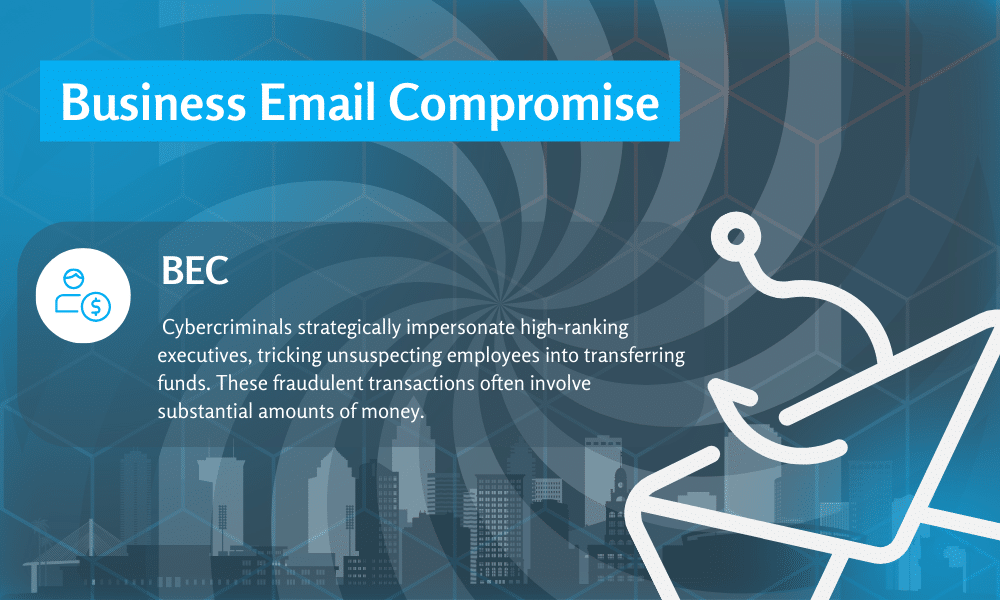
Voice and SMS Phishing
5 & 6) Vishing (Voice Phishing):
Unmasking these threats is crucial for businesses to bolster their defenses against these less conventional yet equally potent tactics.
The unheard threat of Vishing, or voice phishing, and its SMS counterpart, Smishing, poke into exploiting voice and text messages to deceive recipients.
Vishing involves manipulative voice messages, often posing as trusted entities, aiming to extract sensitive information from unsuspecting individuals.
Simultaneously, Smishing capitalizes on the immediacy of text messages to trick recipients into revealing personal details or clicking on malicious links.
These tactics leverage alternative communication channels, navigating around traditional email defenses, making them a challenging and evolving menace.
To fortify their security posture, businesses must prioritize understanding and recognizing the nuances of Vishing and Smishing, implementing robust countermeasures to safeguard against these deceptive and less conventional threats.

7) Credential Harvesting
Various methods employed by cybercriminals to execute credential harvesting schemes involve the creation of deceptive fake login pages, constituting a perilous threat to businesses.
In this sneaky maneuver, malevolent actors meticulously craft counterfeit webpages mirroring legitimate login interfaces of trusted platforms. Unsuspecting users are then lured into entering their login credentials, unknowingly surrendering sensitive information to cybercriminals.
Recognizing and avoiding falling victim to these schemes becomes paramount for businesses striving to protect their data and secure their digital assets.
Vigilance is key, and educating employees about the telltale signs of fake login pages, such as irregular URL structures or subtle design inconsistencies, is essential.
By fostering a culture of heightened awareness and implementing robust cybersecurity measures, businesses can fortify their defences against credential harvesting, thwarting potential breaches and safeguarding the integrity of their sensitive information.
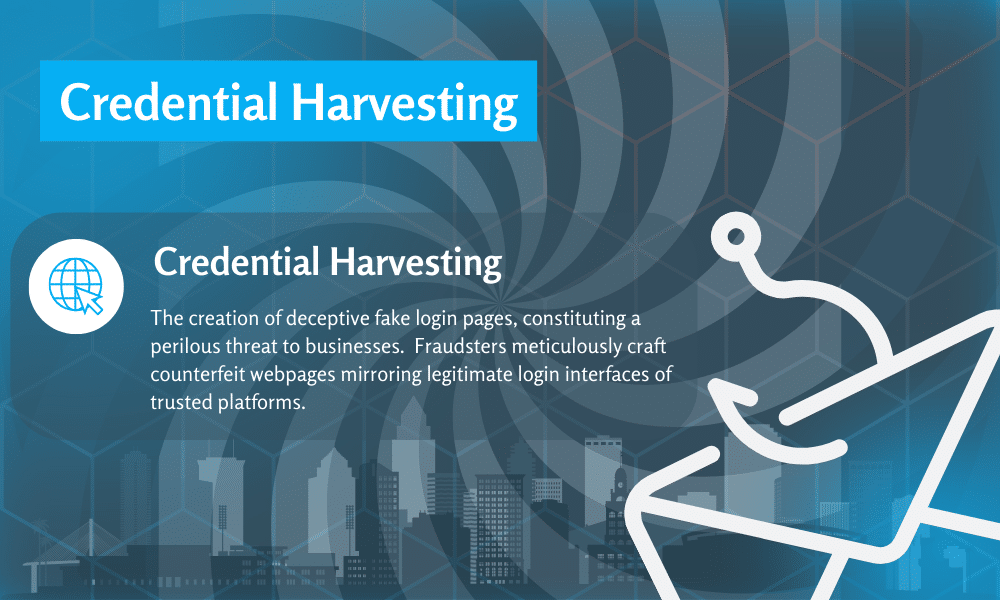
8) Ransomware Attacks
Ransomware, a persistent and lucrative form of cyber extortion, cunningly infiltrates businesses through the seemingly harmless gateway of emails.
In these covert attacks, cybercriminals embed malicious software within seemingly harmless attachments or hyperlinks, exploiting the trust often associated with routine email communication.
Once unwittingly activated, the ransomware encrypts critical files and demands payment for their release.
The sly nature of these attacks lies in their ability to exploit vulnerabilities in human behavior, such as clicking on attachments or links without due scrutiny.
To empower businesses against this growing menace, it is crucial to dissect these attacks, fostering a comprehensive understanding of their tactics.
Vital components in fortifying defenses against ransomware.
- Heightened cybersecurity awareness,
- robust email filtering systems,
- regular employee training,
- and secure backup protocols
By staying informed and implementing proactive measures, businesses can create resilient barriers to protect their data and financial assets from the far-reaching impact of ransomware attacks.
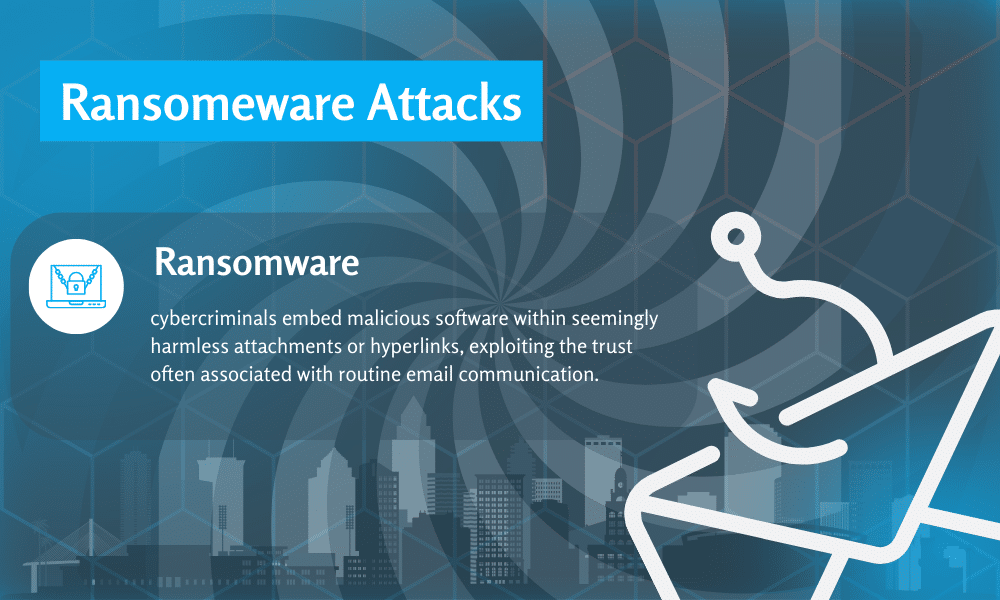
9) Social Engineering Attacks
Unraveling the psychology behind social engineering attacks, particularly through the manipulative tactic of pretexting, unveils a sophisticated web of deception where cyber adversaries exploit human trust.
Pretexting involves the crafty fabrication of scenarios to manipulate individuals into divulging sensitive information.
This form of psychological manipulation plays on human emotions, creating a false sense of urgency or familiarity to coerce victims into sharing confidential data. The success of pretexting lies in the perpetrator’s ability to seamlessly blend into seemingly legitimate roles or situations, making it challenging for individuals to discern the deceit.
Armed with this knowledge, businesses can cultivate a heightened sense of skepticism and critical thinking among employees, emphasizing the importance of verifying requests for sensitive information. By recognizing and thwarting these social engineering tactics, organizations can build a robust human firewall that acts as a formidable defense against the intricate web of psychological manipulation employed by cybercriminals.

10) False Alerts and Notifications
The methods employed by cybercriminals to exploit fake security alerts and trick users form a critical aspect of email-based threats. These deceptive email tactics often involve the fabrication of security notifications that mimic legitimate alerts from trusted sources.
Cyber adversaries play on the inherent concern for online security, instilling a sense of urgency or fear to prompt users into taking immediate, unverified actions.
Recognizing and dismissing false notifications require a discerning eye and a proactive cybersecurity mindset.
Users should scrutinize the sender’s email address, check for inconsistencies in language or formatting, and verify the legitimacy of the security alert through official channels.
Providing insights into these manipulative methods empowers users to distinguish between genuine security alerts and fraudulent attempts, enhancing their ability to thwart cyber threats and preserve the integrity of their digital environments.

Safeguarding Your Business From Deceptive Email Tactics.
In the face of these sophisticated threats, staying informed is the first line of defense.
Employee education and training are pivotal, as is the implementation of robust cybersecurity measures like email filtering and multi-factor authentication.
IGTech 365 stands as a cybersecurity ally, uniquely positioned to deliver comprehensive IT services that shield businesses from these deceptive email tactics.


As we conclude this insightful exploration of deceptive email tactics, we reiterate the imperative for businesses to take proactive steps in fortifying their defenses.
The cyber threat landscape is dynamic, but with the right knowledge and robust cybersecurity measures in place, businesses can navigate these digital waters safely.
IGTech 365 is here to empower businesses, providing not only a shield against these deceptive email tactics but also a strategic partner committed to their cybersecurity resilience.
Ready to fortify your business against deceptive email tactics?
Partner with IGTech 365 for unparalleled managed and outsourced IT services.
Take the first step toward enhanced cybersecurity – claim your free network analysis today.
Let’s safeguard your business together.
Stay in the loop with the latest IT tips, tricks, news, and valuable information! Follow us on social media to effortlessly manage your business’s IT needs, leaving you more time to concentrate on what you love – growing your business.




Recent Comments